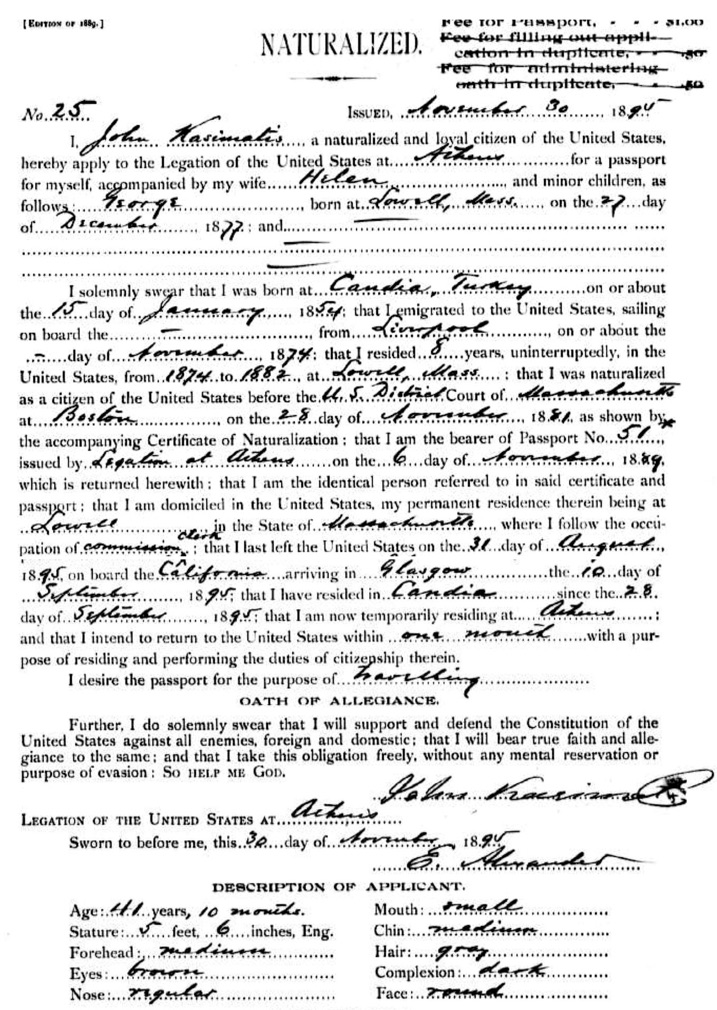The Boston Area’s First Greek Parishes
The first Greek Orthodox church in America was that of the Holy Trinity in New Orleans, La., in 1868. The second was New York City’s Holy Trinity in 1891 and the third Chicago’s Holy Trinity that was founded in 1892. The Boston-area churches followed.
Lowell
The fourth Greek Orthodox parish in America, and first in the Boston area, was Lowell’s Holy Trinity, which was started in 1893 and was serviced by Fr. Kallinikos Dilbey (or Delveis). The church building was dedicated in 1908.
The community started to take shape in 1893-95, when Michael Iatron (or Iatros) founded the Washington-Acropolis Society. He became the parish’s first president and was succeeded by George Gouzoulis in 1908.
Lowell residents born in Greece appear in U.S. Census lists as early as 1850 (i.e. Mary Partridge, 24), but the first Greek of Lowell was probably John Kasimatis who was born in Hania, Crete, then under Turkish occupation. In his passport application he said he had lived in Lowell since 1874 and became a naturalized U.S. citizen in 1881. He was the husband of Helen and the father of George.
The Lowell Hellenic Heritage Association said that about 50 Greeks, mostly peddlers, lived in Lowell in 1891, and about 200 by 1895. Greeks were the third most populous immigrant group in Lowell after the Irish and the French Canadians.
In 1913 Thomas Burgess in his book “Greeks in America” said Greeks started arriving in Lowell in 1892 to work in the mills. He said they spoke no English, stuck together, lived in terrible housing conditions but were hard workers. Employers liked them because they did not drink and did not like to strike. These characteristics made them unpopular with other immigrant workers, so the Greeks had to walk to their homes (mostly on Market Street) in teams!
Lowell’s importance in the life of Greek migration to America is evidenced by the 1906 founding of the first Greek parochial day school in the country (the Hellenic American School) and the 1913 opening of a Greek consulate in the city.
Church life was disrupted between 1934 and 1944 by an old-calendarist priest (Christoforos Contogeorge) who defied Ecumenical Patriarch Photius and the Greek Orthodox Archbishop Athenagoras by establishing in Lowell the Archdiocese of America and Canada, Inc. After several years of litigation, a settlement was reached, the movement was ended and in 1961 the last church belonging it, Lowell’s St. George parish, joined the Greek Orthodox Archdiocese.
Peabody/Salem
In his 1936 book “Η Ιστορία τής Ορθοδόξου Ελληνικής Κοινότητος Peabody-Salem, Massachusetts” (“History of the Greek Orthodox Parish of Peabody-Salem, Massachusetts”), parish priest George Economides said, the Peabody area started seeing Greeks in 1897 with the arrival of brothers Dionysios and Georgios Adrianos from the Georgitsi village outside Sparta. The brothers lived in Lowell but worked in Peabody’s tannery of Alexander B. Clark. According to Economides, by 1900 there were about 50 Greeks in the area, most from Georgitsi, including brothers Christos and Athansasios Sigalas, Pantelis and Ioannis Tsaggaris, Aristeidis Bratsinis, Panagiotis Tserotas, Georgios and Dimitris Katsiris, Dionysios Borilas, Pausanias Alexandropoulos, Andreas Chrysomalis and Georgios Papathanasopoulos. By 1906 there were about 300 Greeks in the Peabody area and it was then that St. Vasilios Greek Orthodox Church was started. Its first priest was George Sakellariou and the first parish council president was Chris Kollinatis.
The first Greeks in Salem in 1898 were: Georgios Kehagias, Konstantinos Christakos, Anastasios Moshidis, Nikolaos Papadogiannis, Elias and Charalambos Gouzoulis, Konstantinos Stamatianos and Konstantinos Papamichail.
Boston
The next parish was that of the Boston Cathedral of the Annunciation, which was started in 1899. The church itself was completed in 1903 and is listed in the U.S. National Register of Historic Places.
According to the cathedral’s website, Boston’s Greek Americans celebrated their first liturgy in 1890 with the help of a Syrian Orthodox priest, who spoke Greek, and performed services in a rented hall on Kneeland and Washington Streets in downtown Boston. Approximately 100 Greeks lived in the area at the time, and community members assisted one another by offering lessons in Greek and English and financial assistance to those of their compatriots in need.




Heading the Boston Cathedral organizational effort, which started in 1899, were M. Anagnos (see earlier section in the site), J. Parmenides, A. Gounaris, S. Stamatelos, A. Stavropoulos, C. Zevitas, P. Govostis, G. Grimoutes, G. Anastasopoulos, E. A. Sophocles (see earlier section in the site), J. M Rodocanachi (see earlier section in the site) and A. Synadinos, among others.







